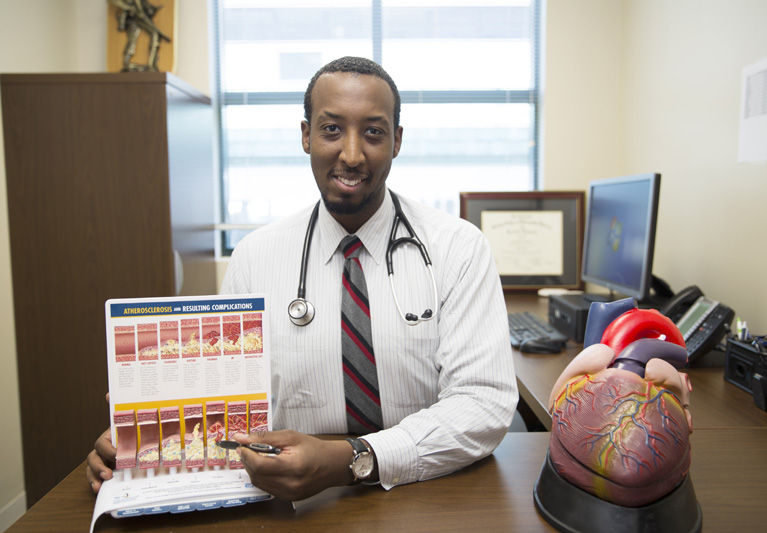
Atrial fibrillation, also known as AF or A-Fib, is a type of arrhythmia or irregular heartbeat – an “often rapid heart rate that commonly causes poor blood flow to the body,” according to the Mayo Clinic.
That might sound relatively benign – at least as far as heart problems go – until you start crunching the numbers.
The Harvard Medical School did crunch those numbers and what it found was anything but benign. “At present,” says the medical school, “between 2.3 million and 5.1 million Americans are affected (by atrial fibrillation) and 150,000 new cases are diagnosed each year.
“The consequences are enormous, including almost 400,000 hospital admissions, 5 million office visits and health care costs of over $6.5 billion a year.
Even worse, AF increases the risk of stroke five-fold and almost doubles the risk of premature death.”
Facing numbers like that, the Heart Center at Indian River Medical Center – an affiliate of Duke Medicine – just added another board-certified cardiologist to its team.
Dr. Daniel Wubneh, a native Floridian and self-professed “Air Force brat,” earned his medical degree from the New York College of Osteopathic Medicine in Glen Head, NY.
He served his residency at the Tampa Bay Heart Institute in St. Petersburg and was the chief cardiology fellow at Ohio Health Doctors Hospital in Columbus, Ohio, before arriving here in Vero.
According to Wubneh, AF is usually categorized as being either “paroxysmal, persistent or permanent.” A paroxysmal or occasional case of AF has symptoms that come and go. Generally they last just a few minutes and then stop on their own. Persistent AF does not stop on its own and will likely require medication or electrical shock to restore a normal rhythm. With permanent AF, as the name implies, normal heart rhythms simply cannot be restored. Most people with permanent AF will need “blood thinners” or anti-coagulants such as warfarin to prevent blood clots from forming.
The Mayo Clinic says, “Some people with atrial fibrillation have no symptoms and are unaware of their condition until it’s discovered during a physical examination. Those who do have atrial fibrillation symptoms may experience signs and symptoms such as palpitations, uncomfortable irregular heartbeats or a flip-flopping in your chest along with a reduced ability to exercise, fatigue, dizziness, confusion or shortness of breath.”
According to the National Heart, Lung and Blood Institute at the National Institutes of Health, understanding AF is almost as much electrical engineering as it is cardiology.
“With each heartbeat,” NHLBI explains, “an electrical signal spreads from the top of the heart to the bottom. As the signal travels, it causes the heart to contract and pump blood.”
The heart consists of four chambers: two upper chambers called “atria” and two lower chambers known as “ventricles.” Within the upper right atrium there are a group of cells called the sinoatrial node or SA which is, in effect, the heart’s natural pacemaker. The SA produces the electrical impulses that start each one of over 115,000 heartbeats a day, 365 days a year.
During an AF episode, those impulses go – well – haywire.
The heart’s two upper chambers can beat chaotically, losing their coordination with the two lower chambers and reducing the heart’s pumping capacity by as much as 30 percent. This can cause blood to pool inside the heart and may lead to blood clots or “thrombs” forming.
If clots do form, they can block the flow of oxygen-rich blood to other organs, including the brain, leading to ischemic strokes, cerebral embolisms and cerebral thrombosis.
Indeed, according to the American Heart Association, blood clots or thrombs are responsible for 87 percent of all strokes.
That’s the reason, Wubneh explains, “Coumadin (warfarin) and some of the other anti-coagulants are so important. They help to prevent the formation of clots in the top chamber of the heart.” This, Wubneh continues, “prevents clots from embolizing or throwing or showering-off to other areas of the body.”
Age and gender are important factors in a person’s susceptibility to developing AF. The Harvard study says it is “uncommon” before the age of 50 and that it occurs 50 percent more frequently in men than in women.
The older the man, the greater the risk.
Harvard says 8 percent of men between 65 and 74 are affected by AF and almost 12 percent of men 75 to 84.
Despite those estimated 5.1 million Americans with AF, researchers still do not know exactly what causes this particular form of arrhythmia.
High blood pressure, heart valve problems and plaque buildup in the arteries have all been put forward as contributing factors but a single trigger has yet to be determined.
The adult human heart, which averages a mere eight to 10 ounces, is an incredibly complex machine. It is the control device for the entire cardiovascular system.
Equipped with the ability to produce its own electricity and with self-regulating valves, the heart is responsible for the flow of blood through a staggering 60,000 miles of veins, arteries and capillaries. (For a comparison, the circumference of the earth is a mere 25,000 miles.)
Like any complex machine, the heart requires specialized care.
If symptoms of any arrhythmia – including AF – occur, see a physician. He or she will likely order an electrocardiogram or other tests to determine if those symptoms are related to atrial fibrillation or some other heart disorder.
As Wubneh explains, “The prolongation or extenuation (of AF) can cause your heart function to be decreased and that can lead to a whole host of other problems” including strokes and myocardial infarction or heart attacks.
Dr. Daniel Wubneh is with the Heart Center of the Indian River Medical Center. His office is at 787 37th Street, Suite E-140. The phone number is 772-778-8687.



